PNY Pro Elite V2 and Elite-X PRO Portable SSDs Review: Performance on a Budget
by Ganesh T S on June 30, 2023 8:00 AM EST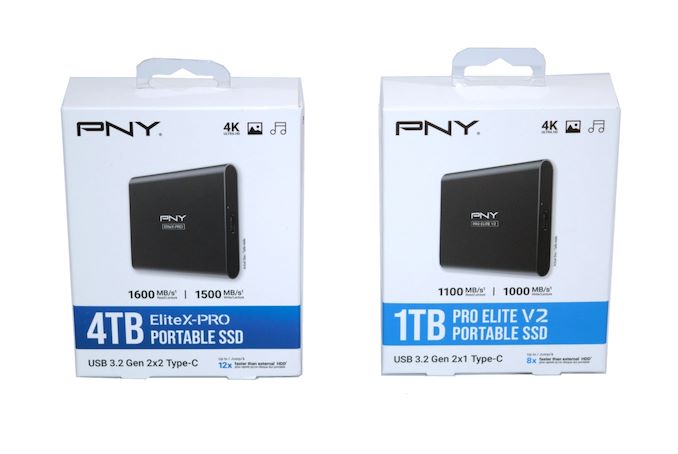
PNY Technologies is well known in the computing industry for its NVIDIA-based graphics cards, but the company also participates in the DRAM and flash-based storage products markets. In the latter, PNY markets a range of USB flash drives, SD cards, and portable SSDs under variations of the 'Elite' tag.
The company launched two new palm-sized portable SSDs earlier this year - the Pro Elite V2 USB 3.2 Gen 2 in the 10 Gbps class, and the EliteX-PRO USB 3.2 Gen 2x2 in the 20 Gbps class. Both products are based on Phison's native USB flash drive (UFD) controllers. Both products come with a Type-C interface. While the Pro Elite V2 is available only in the 500 GB and 1 TB capacity points, the EliteX-PRO has four SKUs with capacities ranging from 500 GB to 4 TB.
The Pro Elite V2 and the EliteX-PRO have identical industrial designs and dimensions, with only the product name printed on the aluminum body serving as a differentiator. The design is reminiscent of the Samsung Portable SSD T5, but manages to retain a more compact and sleek form-factor. This review takes a detailed look at the performance and value proposition of the 1 TB Pro Elite V2 and the 4 TB EliteX-PRO, with a particular focus on how they stack up against the existing players in the segment.
Introduction and Product Impressions
Rapid advancements in flash technology (including the development of 3D NAND and improvements in TLC reliability) have been accompanied by the appearance of faster host interfaces for external devices in the last decade. Together, they have contributed to bus-powered direct-attached storage devices growing in both storage capacity and speeds. The Type-C standard has also achieved widespread acceptance in the consumer market. Protocols such as USB 3.2 Gen 2x2 / USB4 and Thunderbolt riding on top of the Type-C connector have enabled the introduction of palm-sized flash-based storage devices capable of delivering 2GBps+ speeds.
One of the primary challenges with high-speed storage devices is the thermal aspect. Bridge-based solutions with multiple protocol conversion chips tend to dissipate more power due to the additional components. High-performance portable SSDs in the past have had no option but to use them - first, with SATA bridges, and then with NVMe bridges. The introduction of native UFD controllers capable of hitting 10 Gbps and 20 Gbps from Phison and Silicon Motion has opened up yet another option in this category. The Crucial X6, equipped with the Phison U17, was reviewed in August 2021 and was one of the first retail products to surpass the SATA speeds barrier by hitting 800 MBps speeds without using a NVMe bridge. Around the same time, Silicon Motion's SM2320 powered the Kingston XS2000 to 20 Gbps speeds without a bridge in the middle.
Products based on Silicon Motion's SM2320 have gained a lot of consumer mindshare because they have typically been able to hit the interface speed limits for sequential accesses in both the 10 Gbps and 20 Gbps categories. Phison's U17 and U18 were introduced with slightly lower peak performance numbers, and despite vendors like Crucial picking them up for the X6, the products didn't make any waves. The best implementation of Phison's U17, in our opinion, was seen in the OWC Envoy Pro Mini. The introduction of faster flash has since allowed portable SSDs (PSSDs) based on the Phison's native UFD controllers to hit higher speeds. As a result, we have seen an uptick in their adoption. Products such as the Sabrent Rocket Nano v2 and the Corsair EX100U are based on the Phison U18 controller. PNY has also hitched its wagon to the Phison camp for its play in the PSSD market
PNY's 2023 PSSD lineup includes the Pro Elite V2 in the 10 Gbps category, and the EliteX-PRO in the 20 Gbps one. The galleries below present the packaging and teardown process for the two PSSDs.
Both products are similar in terms of packaging (down to the length of the supplied USB Type-C to Type-C and Type-C to Type-A cables) as well as industrial design. The main difference is in the internal PCB.
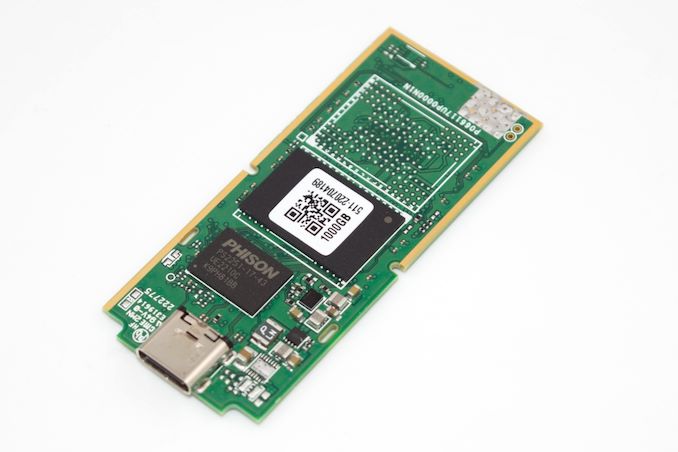
PNY Pro Elite V2 Controller - Phison U17
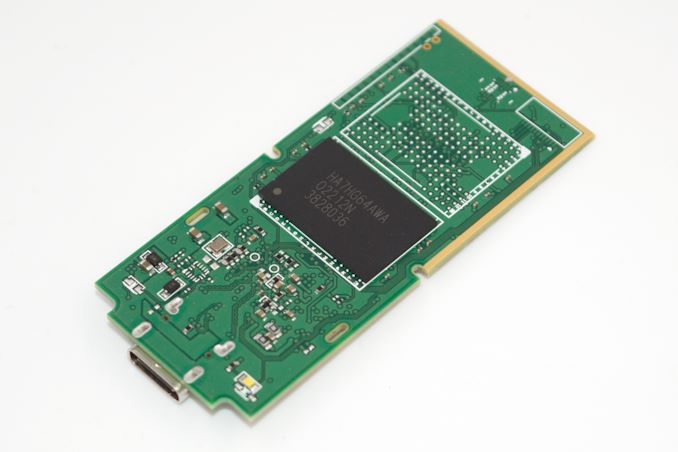
PNY Pro Elite V2 Flash Package - HA7HG64AWA
The 10 Gbps Pro Elite V2 is a Phison U17 design. There is space for four flash packages on the PCB, but PNY has opted only for two packages in the product's top capacity. The HA7HG64AWA is a NAND flash package with 128L 3D TLC from SK hynix. It has 8 x 512 Gbit dies for a total of 512 GB per package. There is one on each side of the PCB.
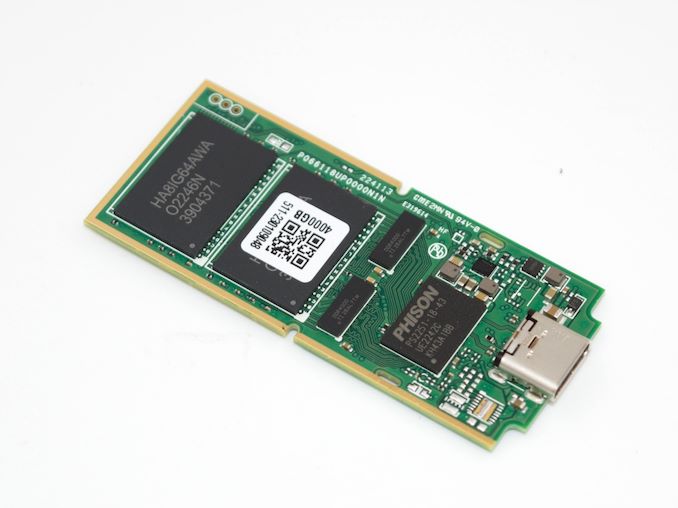
PNY EliteX-PRO Controller - Phison U18
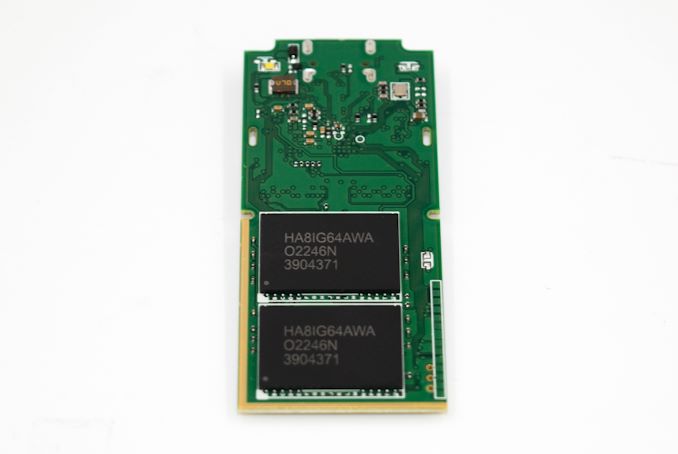
PNY EliteX-PRO Flash Package - HA8IG64AWA
The 20 Gbps EliteX-PRO is a Phison U18 design. There is space for four flash packages on the PCB, and the 4 TB capacity version has all four slots filled up. The HA8IG64AWA is a NAND flash package with 128L 3D TLC from SK hynix. The company's 128L NAND had initially appeared in the form of 512 Gbit dies, but in the second half of 2021, 1 Tbit dies also started appearing (for example, in the 2 TB version of the SK hynix Gold P31). The HA8IG64AWA is likely equipped with 8 x 1 Tbit dies for a total of 1 TB per package. There are two on each side of the PCB in the 4 TB version.
There is no specific thermal solution for the controller or flash in either of the PSSDs. The SK hynix 128L 3D TLC NAND is noted for its power efficiency, and that probably played a role in PNY's decision. The interesting part of the EliteX-PRO PCB is the presence of two TI DDR4000 ICs. These are 1:2 DDR switches / multiplexers. On this PCB, they are used for high-speed signal switching to help interface four flash packages with the two-channel U18 controller.
The industrial design of the Pro Elite V2 and the EliteX-PRO is not unique, with many similarities to the Samsung Portable SSD T5. Thankfully, PNY has opted for an aluminum casing and this lends a solid look and feel to the PSSDs.
Since we are dealing with two different PSSD classes / capacity points, this review will include separate comparison graphs and tables for each. CrystalDiskInfo provides a quick overview of the capabilities of the internal storage device. Despite TRIM not being noted in the features list, we found NTFS volumes on both PSSDs successfully processing TRIM commands from Windows. All S.M.A.R.T features such as temperature read outs worked well.
| S.M.A.R.T Passthrough for 1 TB PSSDs - CrystalDiskInfo | |
 |
 |
| S.M.A.R.T Passthrough for 4 TB PSSDs - CrystalDiskInfo | |
 |
 |
The table below presents a comparative view of the specifications of the different 1 TB PSSDs presented in this review.
| Comparative 1 TB Direct-Attached Storage Devices Configuration | ||
| Aspect | ||
| Downstream Port | Native Flash | Native Flash |
| Upstream Port | USB 3.2 Gen 2 Type-C | USB 3.2 Gen 2 Type-A (Male) |
| Bridge Chip | Phison U17 | Silicon Motion SM2320 |
| Power | Bus Powered | Bus Powered |
| Use Case | Light-weight 1GBps-class portable SSD in a pocketable form-factor | 1GBps-class, compact USB thumb drive with retractable cover for Type-A connector |
| Physical Dimensions | 63.5 mm x 57.2 mm x 10.9 mm | 91.2 mm x 22.3 mm x 9.5 mm |
| Weight | 34 grams (without cable) | 14.5 grams |
| Cable | 18 cm USB 3.2 Gen 2x2 Type-C to Type-C 17 cm USB 3.2 Gen 2 Type-C to Type-A |
N/A |
| S.M.A.R.T Passthrough | Yes | Yes |
| UASP Support | Yes | Yes |
| TRIM Passthrough | Yes | Yes |
| Hardware Encryption | Not Available | Not Available |
| Evaluated Storage | SK hynix 128L 3D TLC | Toshiba BiCS5 112L 3D TLC |
| Price (Launch) | USD 70 | USD 180 |
| Review Link | PNY Pro Elite V2 Portable SSD 1TB Review | Kingston DTMAXA/1TB Review |
The equivalent comparison table for the 4 TB PSSDs is presented below.
| Comparative Direct-Attached Storage Devices Configuration | ||
| Aspect | ||
| Downstream Port | Native Flash | PCIe 3.0 x2 |
| Upstream Port | USB 3.2 Gen 2x2 Type-C | USB 3.2 Gen 2 Type-C |
| Bridge Chip | Phison U18 | ASMedia ASM2362 |
| Power | Bus Powered | Bus Powered |
| Use Case | Light-weight 2GBps-class portable SSD in a pocketable form-factor | Light-weight 1GBps-class portable SSD with a durability focus (IP65 rating) |
| Physical Dimensions | 63.5 mm x 57.2 mm x 10.9 mm | 88 mm x 59 mm x 13 mm |
| Weight | 35 grams (without cable) | 98 grams |
| Cable | 18 cm USB 3.2 Gen 2x2 Type-C to Type-C 17 cm USB 3.2 Gen 2 Type-C to Type-A |
45 cm USB 3.2 Gen 2 Type-C to Type-C 45 cm USB 3.2 Gen 2 Type-C to Type-A |
| S.M.A.R.T Passthrough | Yes | Yes |
| UASP Support | Yes | Yes |
| TRIM Passthrough | Yes | Yes |
| Hardware Encryption | Not Available | Yes |
| Evaluated Storage | SK hynix 128L 3D TLC | Samsung 136L V-NAND (6th Gen.) |
| Price (Launch) | USD 300 | USD 410 |
| Review Link | PNY EliteX-PRO Portable SSD 4TB Review | Samsung Portable SSD T7 Shield 4TB Review |
Prior to looking at the benchmark numbers, power consumption, and thermal solution effectiveness, a description of the testbed setup and evaluation methodology is provided.
Testbed Setup and Evaluation Methodology
Direct-attached storage devices (including thumb drives) are evaluated using the Quartz Canyon NUC (essentially, the Xeon / ECC version of the Ghost Canyon NUC) configured with 2x 16GB DDR4-2667 ECC SODIMMs and a PCIe 3.0 x4 NVMe SSD - the IM2P33E8 1TB from ADATA.
The most attractive aspect of the Quartz Canyon NUC is the presence of two PCIe slots (electrically, x16 and x4) for add-in cards. In the absence of a discrete GPU - for which there is no need in a DAS testbed - both slots are available. In fact, we also added a spare SanDisk Extreme PRO M.2 NVMe SSD to the CPU direct-attached M.2 22110 slot in the baseboard in order to avoid DMI bottlenecks when evaluating Thunderbolt 3 devices. This still allows for two add-in cards operating at x8 (x16 electrical) and x4 (x4 electrical). Since the Quartz Canyon NUC doesn't have a native USB 3.2 Gen 2x2 port, Silverstone's SST-ECU06 add-in card was installed in the x4 slot. All non-Thunderbolt devices are tested using the Type-C port enabled by the SST-ECU06.
The specifications of the testbed are summarized in the table below:
| The 2021 AnandTech DAS Testbed Configuration | |
| System | Intel Quartz Canyon NUC9vXQNX |
| CPU | Intel Xeon E-2286M |
| Memory | ADATA Industrial AD4B3200716G22 32 GB (2x 16GB) DDR4-3200 ECC @ 22-22-22-52 |
| OS Drive | ADATA Industrial IM2P33E8 NVMe 1TB |
| Secondary Drive | SanDisk Extreme PRO M.2 NVMe 3D SSD 1TB |
| Add-on Card | SilverStone Tek SST-ECU06 USB 3.2 Gen 2x2 Type-C Host |
| OS | Windows 10 Enterprise x64 (21H1) |
| Thanks to ADATA, Intel, and SilverStone Tek for the build components | |
The testbed hardware is only one segment of the evaluation. Over the last few years, the typical direct-attached storage workloads for memory cards have also evolved. High bit-rate 4K videos at 60fps have become quite common, and 8K videos are starting to make an appearance. Game install sizes have also grown steadily even in portable game consoles, thanks to high resolution textures and artwork. Keeping these in mind, our evaluation scheme for portable SSDs and UFDs involves multiple workloads which are described in detail in the corresponding sections.
- Synthetic workloads using CrystalDiskMark and ATTO
- Real-world access traces using PCMark 10's storage benchmark
- Custom robocopy workloads reflective of typical DAS usage
- Sequential write stress test
In the next couple of sections, we have an overview of the performance of the two PNY PSSDs in these benchmarks. Prior to providing concluding remarks, we have some observations on the drives' power consumption numbers and thermal solution also.























4 Comments
View All Comments
garblah - Friday, June 30, 2023 - link
According to the box it supports 4K. That's good to know.But I suppose if you're designing the box art then your target audience is the average walk-in customer at Best Buy or Walmart.
PeachNCream - Tuesday, July 4, 2023 - link
To be fair, uninformed purchasing appears the norm in the US. Why else should marketing work so well on the average person if they'd done any research?evilspoons - Monday, July 10, 2023 - link
Some of your CrystalDiskMark device result screenshots are in IOPS and some are in MB/s. This makes the comparison between the OWC and Kingston 1 TB devices look incredibly lopsided on everything except the SEQ1M test.pipama09 - Wednesday, August 23, 2023 - link
hello